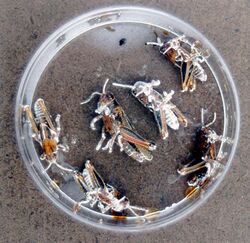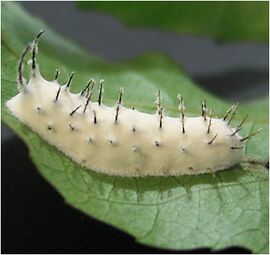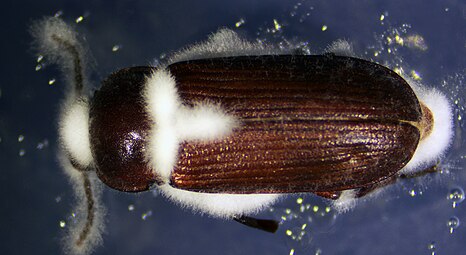Biology:Beauveria bassiana
| Beauveria bassiana | |
|---|---|

| |
| Grasshoppers killed by B. bassiana | |
| Scientific classification | |
| Domain: | Eukaryota |
| Kingdom: | Fungi |
| Division: | Ascomycota |
| Class: | Sordariomycetes |
| Order: | Hypocreales |
| Family: | Cordycipitaceae |
| Genus: | Beauveria |
| Species: | B. bassiana
|
| Binomial name | |
| Beauveria bassiana (Bals.-Criv.) Vuill. (1912)
| |
| Synonyms | |
| |
Beauveria bassiana is a fungus that grows naturally in soils throughout the world and acts as a parasite on various arthropod species, causing white muscardine disease; it thus belongs to the group of entomopathogenic fungi. It is used as a biological insecticide to control a number of pests, including termites, thrips, whiteflies, aphids and various beetles. Its use in the control of bedbugs[1] and malaria-transmitting mosquitos is under investigation.[2]
Discovery and name
The species is named after the Italian entomologist Agostino Bassi, who discovered it in 1835 in silkworms (Bombyx mori).[3] Bassi performed the first infection experiments, and determined the fungus to be the cause of the muscardine disease, which then led to carriers transmitting it by airborne means. Later the same year, the fungus was named Botrytis bassiana by Giuseppe Gabriel Balsamo-Crivelli.[3] The species epithet honours Bassi, the discoverer:[3]
In 1911 Jean Beauverie did further study and the next year Jean Paul Vuillemin made it the type species of his new genus, Beauveria, a name which honors Beauverie.[4][3]
The name B. bassiana has long been used to describe a species complex of morphologically similar and closely related isolates. Rehner and Buckley[5] have shown that B. bassiana consists of many distinct lineages that should be recognized as distinct phylogenetic species and the genus Beauveria was redescribed with a proposed type for B. bassiana in 2011.[6]
The species was formerly also known as Tritirachium shiotae, mong other synonyms.
Relation to Cordyceps and other fungi
Beauveria bassiana is the anamorph (asexually reproducing form) of Cordyceps bassiana. The latter teleomorph (the sexually reproducing form) has been collected only in eastern Asia.[7]
White muscardine disease
The insect disease caused by the fungus is a muscardine which has been called white muscardine disease. When the microscopic spores of the fungus come into contact with the body of an insect host, they germinate, penetrate the cuticle, and grow inside, killing the insect within a matter of days. Afterwards, a white mold emerges from the cadaver and produces new spores. A typical isolate of B. bassiana can attack a broad range of insects; various isolates differ in their host range. The factors responsible for host susceptibility are not known.[citation needed]
Beauveria bassiana parasitizing the Colorado potato beetle has been reported to be, in turn, the host of a mycoparasitic fungus Syspastospora parasitica.[8] This organism also attacks related insect-pathogenic species of the Clavicipitaceae.
Morphology of the fungus
B. bassiana is a white mould when grown on culture, producing white spore balls made up of many conidia that are single-celled, haploid, and hydrophobic.[9][10] The short, ovoid conidiogenous cells that produce the conidia have a narrow apical extension called a rachis, which elongates into a long zig-zag extension.[11][10]
Use in biological control of insects
Beauveria bassiana can be used as a biological insecticide to control a number of pests such as termites, whiteflies, and many other insects. Its use in the control of malaria-transmitting mosquitos is under investigation.[2] As an insecticide, the spores are sprayed on affected crops as an emulsified suspension or wettable powder or applied to mosquito nets as a mosquito control agent.
As a species, Beauveria bassiana parasitizes a very wide range of arthropod hosts. However, different strains vary in their host ranges, some having rather narrow ranges, like strain Bba 5653 that is very virulent to the larvae of the diamondback moth and kills only few other types of caterpillars. Some strains do have a wide host range and should, therefore, be considered nonselective biological insecticides. These should not be applied to flowers visited by pollinating insects.[12]
Known targets include:[13][14][15]
- Aphids
- Whiteflies
- Mealybugs
- Psyllids
- Chinch bug
- Lygus bugs
- Grasshoppers
- Stink bugs (Halyomorpha halys)[16]
- Thrips
- Termites
- Fire ants
- Flies
- Stem borers
- Fungal gnats
- Shoreflies
- Beetles
- Bark beetle[17]
- Black vine weevil
- Boll weevil
- Cereal leaf beetle
- Coffee berry borer
- Colorado potato beetle
- Emerald ash borer (in conjunction with the parasitoid wasp Tetrastichus planipennisi)[18]
- Japanese beetle
- Mexican bean beetle
- Red palm weevil[19]
- Strawberry root weevil
- Caterpillars
- Codling moth
- Douglas fir tussock moth
- European corn borer
- Invasive silkworms
- Apple clearwing moth[20]
- Mites
The fungus rarely infects humans or other animals, so it is generally considered safe as an insecticide. However, at least one case of human infection by B. bassiana has been reported in a person with a suppressed immune system.[21] Additionally, the spores may exacerbate breathing difficulties. Wagner and Lewis reported the ability of B. bassiana to grow as an endophyte in corn.[22]
A fungus attributed to be B. bassiana was observed to cause infections in a captive American alligator[23] and B. bassiana was implicated in causing a pulmonary disease in captive tortoises.[24][25] The reptiles were in captivity and under temperature stress which may explain their susceptibility to the fungus. When a tortoise was kept at 22 °C and injected with 0.5 mL of 106 spores of B. bassiana into the lung, no mortality was observed, while a second contaminated tortoise died when kept only at 16 °C.[26]
Preliminary research has shown the fungus is 100% effective in eliminating bed bugs exposed to cotton fabric sprayed with fungus spores. It is also effective against bed bug colonies due to B. bassiana carried by infected bugs back to their harborages. The tested strain of B bassiana caused rapid mortality (3 – 5 days) after short-term exposure.[1] In a 2017 follow-up study, pyrethroid-resistant bed bugs had >94% mortality after treatment with a commercial preparation of B. bassiana.[27]
A microevolutionary experiment in 2013 showed that the Greater wax moth (Galleria mellonella) was able to adapt its defense mechanisms during 25 generations, while being under constant selective pressure from the fungus B. bassiana. The moth developed resistance, but apparently, at a cost.[28]
Containment leak
In March 2013, genetically modified Beauveria bassiana was found in a number of research laboratories and greenhouses outside of a designated containment area at Lincoln University in Christchurch, New Zealand. The Ministry for Primary Industries investigated the leak.[29]
Gallery
See also
- Biological insecticides
- Metarhizium spp. which cause "green muscardine" disease
References
- ↑ 1.0 1.1 Barbarin, Alexis M.; Jenkins, Nina E.; Rajotte, Edwin G.; Thomas, Matthew B. (15 September 2012). "A preliminary evaluation of the potential of Beauveria bassiana for bed bug control". Journal of Invertebrate Pathology 111 (1): 82–85. doi:10.1016/j.jip.2012.04.009. PMID 22555012. http://www.thethomaslab.net/uploads/Barbarin2012.pdf. Retrieved 21 November 2012.
- ↑ 2.0 2.1 Donald G. McNeil Jr., Fungus Fatal to Mosquito May Aid Global War on Malaria, The New York Times, 10 June 2005
- ↑ 3.0 3.1 3.2 3.3 Imoulan, Abdessamad; Hussain, Muzammil; Kirk, Paul M.; Meziane, Abdellatif El; Yao, Yi-Jian (2017-12-01). "Entomopathogenic fungus Beauveria: Host specificity, ecology and significance of morpho-molecular characterization in accurate taxonomic classification". Journal of Asia-Pacific Entomology 20 (4): 1204–1212. doi:10.1016/J.ASPEN.2017.08.015.
- ↑ Zimmermann, Gisbert (2007). "Review on safety of the entomopathogenic fungi Beauveria bassiana and Beauveria brongniartii". Biocontrol Science and Technology (Taylor & Francis) 17 (6): 553–596. doi:10.1080/09583150701309006. ISSN 0958-3157. Bibcode: 2007BioST..17..553Z.
- ↑ "A Beauveria phylogeny inferred from nuclear ITS and EF1-{alpha} sequences: evidence for cryptic diversification and links to Cordyceps teleomorphs". Mycologia 97 (1): 84–98. 2005. doi:10.3852/mycologia.97.1.84. PMID 16389960. https://naldc-legacy.nal.usda.gov/naldc/download.xhtml?id=37383&content=PDF.
- ↑ Rehner, Stephen A.; Minnis, Andrew M.; Sung, Gi-Ho; Luangsaard, J. Jennifer; Devotto, Luis; Humber, Richard A. (2011). "Phylogeny and systematics of the anamorphic, entomopathogenic genus Beauveria". Mycologia 103 (5): 1055–1073. doi:10.3852/10-302. PMID 21482632. https://tede.ufrrj.br/jspui/handle/jspui/2725.
- ↑ "Discovery and demonstration of the teleomorph of Beauveria bassiana (Bals.) Vuill., an important entomogenous fungus". Chinese Science Bulletin 46 (9): 751–3. 2001. doi:10.1007/BF03187215. Bibcode: 2001ChSBu..46..751L.
- ↑ Posada, F. (2004). "Syspastospora parasitica, a mycoparasite of the fungus Beauveria bassiana attacking the Colorado potato beetle Leptinotarsa decemlineata: a tritrophic association". J. Insect Sci. 4: 24. doi:10.1093/jis/4.1.24. PMID 15861239.
- ↑ Keerthi, M. C.; Darshan, K.; Manjunatha, L.; Reddy, P. V. Rami (2022-01-01). "Status and scope of entomopathogenic fungus, Beauveria bassiana in sustainable pest management: A review". Pest Management in Horticultural Ecosystems 28 (2): 1–14. doi:10.5958/0974-4541.2022.00031.5.
- ↑ 10.0 10.1 S, Wargane, V.; R, Parate, S.; B, Bramhankar, S.; N, Rakhonde, P.; D, Sonune, B.; K, Mane, K.; V, Lavhe, N. (2020-01-01). "Cultural and morphological characterizations of Beauveria bassiana". Journal of Pharmacognosy and Phytochemistry 9 (1): 591–594.
- ↑ Mitani, Arisa; Shiraishi, Atsushi; Miyamoto, Hitoshi; Sunada, Atsuko; Ueda, Akiko; Asari, Seishi; Zheng, Xiaodong; Yamamoto, Yasuaki et al. (2014-09-27). "Fungal keratitis caused by Beauveria bassiana: drug and temperature sensitivity profiles: a case report". BMC Research Notes 7: 677. doi:10.1186/1756-0500-7-677. PMID 25260975.
- ↑ "EPA Factsheet". http://www.epa.gov/pesticides/biopesticides/ingredients/factsheets/factsheet_128924.htm.
- ↑ "Cornell Extension Service". http://www.nysaes.cornell.edu/ent/biocontrol/pathogens/fungi.html.
- ↑ "University of Connecticut Extension". http://www.hort.uconn.edu/IPM/general/htms/bassiana.htm.
- ↑ "University of Minnesota Extension". http://www.entomology.umn.edu/cues/blackvw/blackve.html.
- ↑ Gouli, Vladimir; Gouli, Svetlana; Skinner, Margaret; Hamilton, George; Kim, Jae Sue; Parker, Bruce L (February 2012). "Virulence of select entomopathogenic fungi to the brown marmorated stink bug, Halyomorpha halys (Stål) (Heteroptera: Pentatomidae)". Pest Management Science 68 (2): 155–157. doi:10.1002/ps.2310. PMID 22223199.
- ↑ Mann, Andrew; Davis, Thomas (2020). "Plant secondary metabolites and low temperature are the major limiting T factors for Beauveria bassiana (Bals.-Criv.) Vuill. (Ascomycota: Hypocreales) growth and virulence in a bark beetle system". Biological Control 141: 104130. doi:10.1016/j.biocontrol.2019.104130. Bibcode: 2020BiolC.14104130M.
- ↑ "Biocontrol: Fungus and Wasps Released to Control Emerald Ash Borer". Science News. ScienceDaily. 26 April 2011. https://www.sciencedaily.com/releases/2011/04/110426111415.htm.
- ↑ Un hongo acaba con el 75% del picudo rojo que afecta al conjunto del Palmeral de Elche (in Spanish)
- ↑ Cossentine, J. E.; Judd, G. J. R.; Bissett, J. D.; Lacey, L. A. (2010-01-01). "Susceptibility of apple clearwing moth larvae, Synanthedon myopaeformis (Lepidoptera: Sesiidae) to Beauveria bassiana and Metarhizium brunneum". Biocontrol Science and Technology 20 (7): 703–707. doi:10.1080/09583151003690390. ISSN 0958-3157. Bibcode: 2010BioST..20..703C.
- ↑ "Disseminated Beauveria bassiana infection in a patient with acute lymphoblastic leukemia". J. Clin. Microbiol. 42 (11): 5412–4. November 2004. doi:10.1128/JCM.42.11.5412-5414.2004. PMID 15528759.
- ↑ "Colonization of corn, Zea mays, by the entomopathogenic fungus Beauveria bassiana". Appl. Environ. Microbiol. 66 (8): 3468–73. August 2000. doi:10.1128/AEM.66.8.3468-3473.2000. PMID 10919808. Bibcode: 2000ApEnM..66.3468W.
- ↑ Jensen, J. M.; Robinson, B. E.; Bulmer, G. S. (July 1979). "Fatal Mycotic Pulmonary Disease of Captive American Alligators". Veterinary Pathology 16 (4): 428–431. doi:10.1177/030098587901600405. ISSN 0300-9858. PMID 452316.
- ↑ Georg, Lucille K.; Williamson, W.M.; Tilden, Evelyn B.; Getty, Ruth E. (1962). "Mycotic pulmonary disease of captive giant tortoises due toBeauvaria bassianaandPaecilomyces fumoso-roseus". Medical Mycology 2 (2): 80–86. doi:10.1080/00362176385190161. ISSN 1369-3786.
- ↑ Cabo, J. F. González; Serrano, J. Espejo; Asensio, M. C. Bárcena (March 1995). "Mycotic pulmonary disease byBeauveria bassianain a captive tortoise". Mycoses 38 (3–4): 167–169. doi:10.1111/j.1439-0507.1995.tb00043.x. ISSN 0933-7407. PMID 7477096.
- ↑ Müller-Kögler, E. (December 1967). "Nebenwirkungen Insektenpathogener Pilze Auf Mensch und Wirbeltiere: Aktuelle Fragen". Entomophaga 12 (4): 429–441. doi:10.1007/bf02376929. ISSN 0013-8959.
- ↑ Barbarin, Alexis (20 March 2017). "Susceptibility of insecticide-resistant bed bugs (Cimex lectularius) to infection by fungal biopesticide". Pest Management Science 73 (8): 1568–1573. doi:10.1002/ps.4576. PMID 28321982.
- ↑ Dubovskiy, Ivan M.; Whitten, Miranda M. A.; Yaroslavtseva, Olga N.; Greig, Carolyn; Kryukov, Vadim Y.; Grizanova, Ekaterina V.; Mukherjee, Krishnendu; Vilcinskas, Andreas et al. (2013-04-01). Leulier, François. ed. "Can Insects Develop Resistance to Insect Pathogenic Fungi?". PLoS ONE (Public Library of Science) 8 (4): e60248. doi:10.1371/journal.pone.0060248. ISSN 1932-6203. PMID 23560083. Bibcode: 2013PLoSO...860248D.
- ↑ "Genetically modified fungus leaked". 3 News NZ. March 20, 2013. http://www.3news.co.nz/Genetically-modified-fungus-leaked/tabid/423/articleID/291058/Default.aspx.
Further reading
- "Activity of oil-formulated Beauveria bassiana against Triatoma sordida in peridomestic areas in Central Brazil". Mem. Inst. Oswaldo Cruz 99 (2): 211–8. March 2004. doi:10.1590/S0074-02762004000200017. PMID 15250478.
- "Infectivity of oil and water formulations of Beauveria bassiana (Deuteromycotina; Hyphomycetes) to the cocoa weevil pest Pantorhytes plutus (Coleoptera: Curculionidae)". Journal of Invertebrate Pathology 52 (1): 66–72. 1988. doi:10.1016/0022-2011(88)90103-6.
External links
- Beauveria bassiana discussed on RNZ Critter of the Week, 1 September 2023
Wikidata ☰ Q2345333 entry
 |







